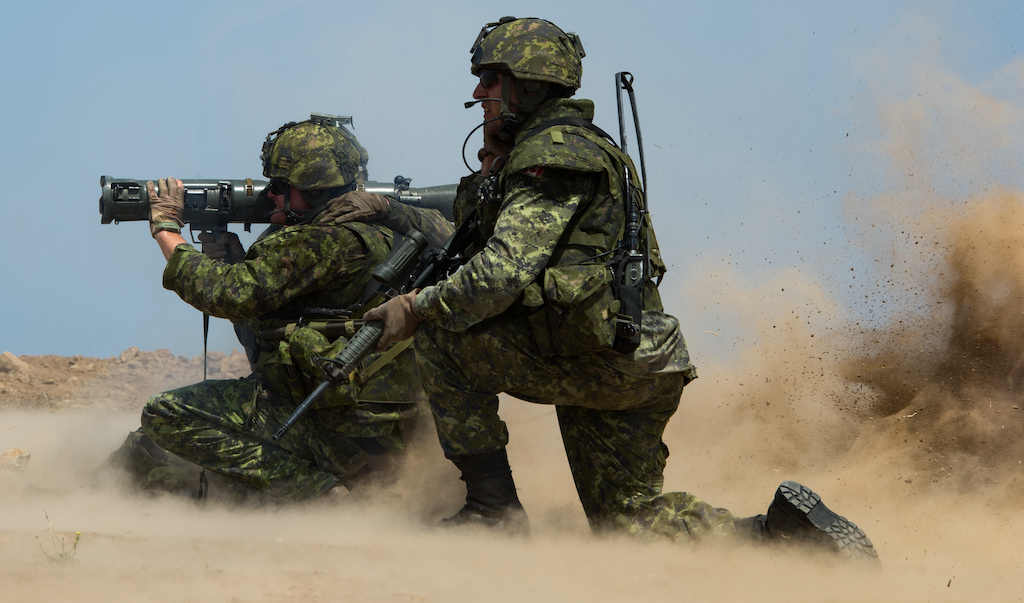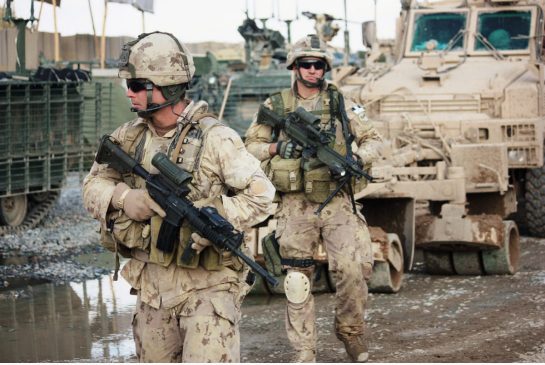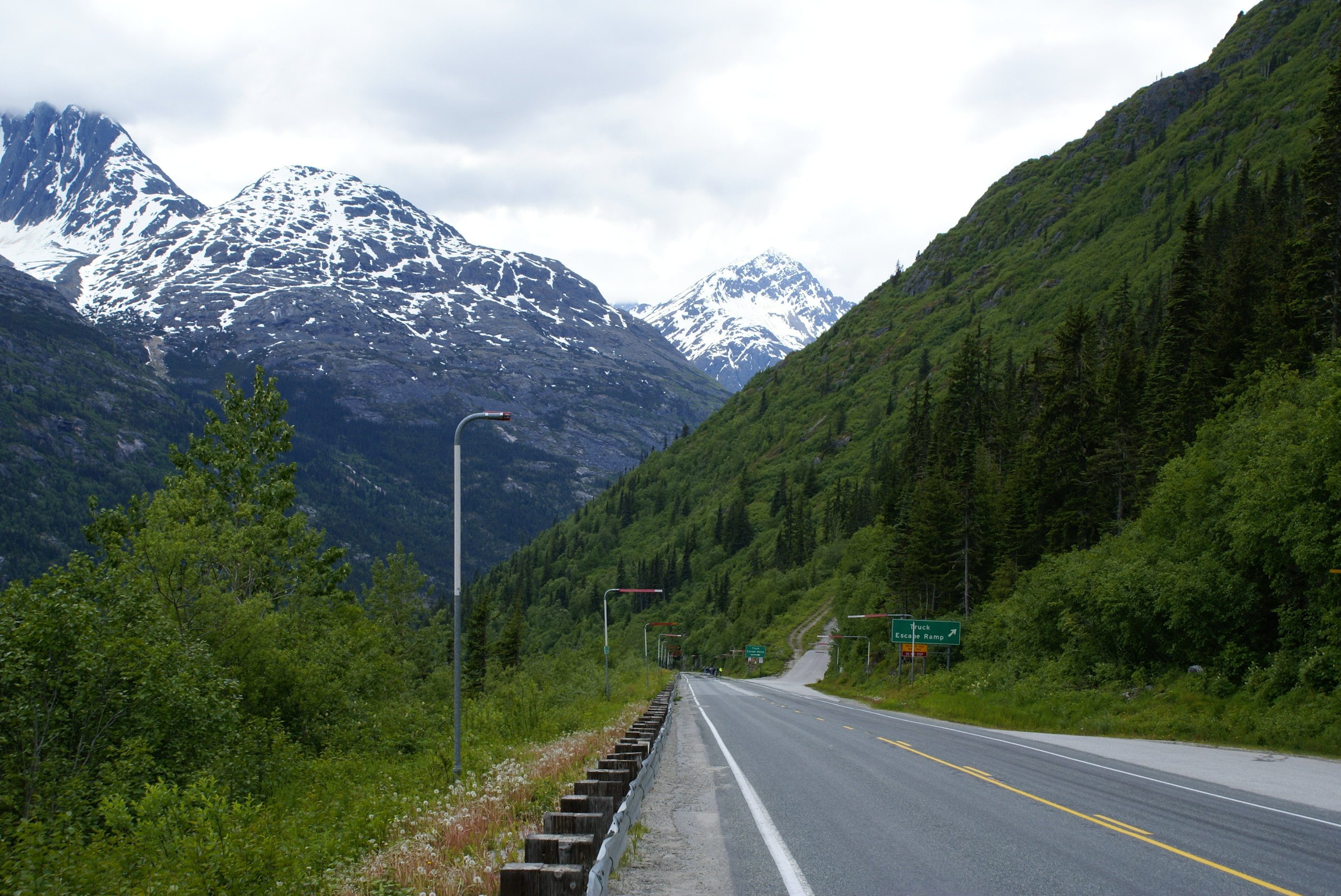Smoke has occasionally lingered over large parts of North America this summer, a by-product of an “unprecedented wildfire season” in Canada. Exacerbated by climate change, the fires demonstrate that shifting weather patterns are contributing to more particulate matter (PM), “a complex mixture of small airborne liquid and solid particles that are classified by size” that coalesce from assorted organic and inorganic elements, such as smoke and dust. A rising incidence of PM-linked health effects and deaths could affect the welfare of the Canadian Armed Forces (CAF), whose personnel already face occupational respiratory dangers, including those increasingly connected to fire-fighting duties. This article briefly revisits the established dangers of PM, such as dust, for military personnel before elaborating on and assessing some of the planning, monitoring, and mitigation measures that the CAF has implemented to address this challenge.
Climate change is reshaping the environment in ways that bring about a rise in PM and fuel poor air quality. Higher temperatures and less rain will mean more drought and the expansion of drier and depleted spaces—“desertification”—as well as fires that will yield more smoke and dust. Mounting fossil-fuel emissions will compound the problem.
Simultaneously, CAF members will still have to contend with battlefield-related PM. As detailed, burn pits, vehicle emissions, and metal chaff all represent potential respiratory health hazards for personnel. Moreover, improvised explosive devices (IEDs), ordnance, and smalls-arms ammunition can diffuse metals, such as uranium and lead, into the environment and thus lungs.
Planning and monitoring are pillars of the CAF’s approach to PM and other airborne hazards. Within the CAF’s Health Services Group exists the Directorate Force Health Protection (DFHP), which oversees the Deployable Health Hazard Assessment Team (DHHAT). DFHP and DHHAT work together “to conduct pre-deployment assessments of potential health hazards in CAF areas of operation.” The ensuing “sampling plan” informs any subsequent “technical assistance visit to the deployed setting,” where DHHAT gathers “environmental samples” for laboratory-based review “to identify compounds of potential concern…to CAF members’ health.” This apparatus enables monitoring before and during deployments around the world, including Afghanistan, which has received particular coverage in specialized and popular publications.
The collected data, in turn, get analyzed in light of established standards, of which a number exist. The Canadian ambient air quality standards set the exposure recommendations on “fine PM” (PM 2.5) and other “selected air pollutants” nationally. In Afghanistan, authorities assessed hazards based on a patchwork of standards, including the “American Conference of Governmental Industrial Hygienists (ACGIH) Threshold Limits Values (TLV) time-weighted average (TWA),” and “Ontario ambient air quality criteria for dioxins and furans (D/F).”
Certain factors could limit DHHAT’s monitoring effectiveness in an era of worsening air quality. While ultimately deemed “reasonable,” an overview of DHHAT teams in Afghanistan notes the potential constraints of following civilian exposure standards, observing: “These occupational standards are not completely suitable for CAF personnel in deployed settings because CAF personnel could be exposed to compounds in air for periods exceeding the standard 8-hour work day and 40-hour workweek.” DHHAT’s size could prove another consideration. DHHAT has had limited personnel in the past. In September 2003, for instance, it reportedly fielded three “teams,” each with a full-time complement that numbered three.
Whatever the challenges, the joint efforts of DFHP and DHHAT are vital for guiding mitigation efforts. Armed with relevant data, “DFHP prepares a report that contains proposed mitigation measures to reduce potential occupational and environmental exposures.”
Mitigation includes behavioural modifications. These measures can encompass evacuating or halting deployments of at-risk individuals, which occurred after a garbage mound ignited in nearby Iqaluit during the 2014 iteration of Operation NANOOK. Meanwhile, for those who must deploy amid periods of deteriorating air quality, such as “dust events,” DHHAT recommends “reducing heavy outdoor activities as well as by moving indoors.”
However, circumstances do not always permit personnel to remain inside. In these situations, personal protective equipment can minimize PM exposure. According to “Flight Safety for the Canadian Armed Forces,” the “Disposable Industrial Dust Mask” or N95 “provides adequate protection from particulate hazards such as composite fibres, lead oxide dust, depleted uranium dust and asbestos.” The “Reusable Half Face Piece Respirator” and gas mask offer additional layers of protection.
Still, existing filtration systems have shortcomings. Of the N95, the U.S. Army Public Health Command notes that “clogging, discomfort, and interference with operations” can occur while wearing the masks. Arjun Grewal, who helms Ventus Respiratory Technologies, agrees, noting that the N95 is encumbering and the gas mask “impractical” for regular use.
These deficiencies have prompted development of “lightweight, pressurized military respirators with powerful filtration systems,” which could describe Ventus Respiratory Technologies’ TR2. This model, which is reportedly being considered by elements of the CAF, claims to afford better protection than the N95 while remaining “less burdensome than a gas mask.”
Curbing “ambient air pollution,” though, requires cutting emissions through more environmentally friendly methods of waste disposal, for example. The Department of National Defence (DND) partnered with its American counterparts to devise the Micro Auto Gasification System (MAGS), which facilitated incinerating trash without generating harmful by-products (i.e., “inert”). In 2012, DND and Eco Waste Solutions (EWS) inked a contract for a portable “ECO Mobile waste incineration system.”
Reducing potentially hazardous emissions from gasoline- and diesel-powered vehicles is another means of cutting emissions that the CAF and DND have pursued or investigated. Indeed, utilizing more “sustainable fuels” and procuring “greener” vehicles appear as goals in “Defence Energy and Environment Strategy 2020-2023” (DEES). According to DEES, “[a]s of 2019-20, 33% of Defence’s commercial light-duty fleet were hybrid, plug-in hybrid and zero emissions.” However, given a number of confounding variables, operationalizing these green technologies in combat vehicles is considerably more difficult but a topic that the Canadian defence establishment has studied.
Beyond emissions, taking steps to reduce respiratory irritants or contaminants that can coat landscapes is an additional mitigating measure available to militaries. The Norwegian Defence Research Establishment, for instance, has reportedly investigated armaments with a lower potential for diffusing dangerous substances. Similarly, the Canadian defence establishment has experimented with “greener” propellants—that is, ordnance with a less toxic footprint—in munitions.
With PM worsening, DND and the CAF will need to continue to build on and bolster existing monitoring and mitigation initiatives. This could include enhancing monitoring activities, devising up-to-date and military-specific guidelines and procedures for personnel deploying under poor air quality, procuring and developing next-generation mitigation technologies, and investing in emissions-reducing systems and platforms. In all of these instances, research and development initiatives—conducted through DND’s Innovation for Defence Excellence and Security (IDEaS) Human Performance in Extreme Climatic Environments challenge, for instance—will prove useful in safeguarding force welfare and ensuring operational success during intensifying periods of poor air quality.
Photo: “Members of the Canadian 2nd Battalion Royal 22e Régiment fire a C84mm Carl Gustaf recoilless rifle during live fire platoon attacks at range 800 during the biennial Rim of the Pacific (RIMPAC) Exercise, Marine Corps Base Camp Pendleton, July 10,” July 10, 2018, by Canadian Armed Forces photo by Ordinary Seamen Justin Spinello, via Flickr. Licensed under CC BY-NC 2.0.
Disclaimer: Any views or opinions expressed in articles are solely those of the authors and do not necessarily represent the views of the NATO Association of Canada.




